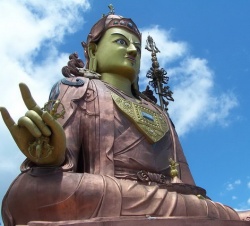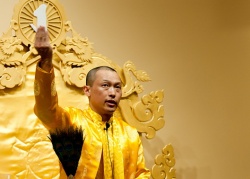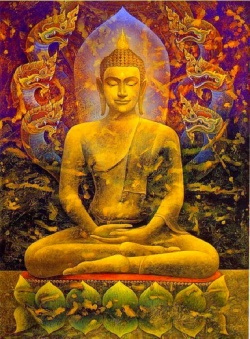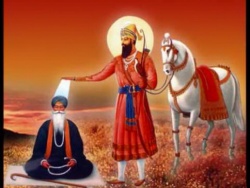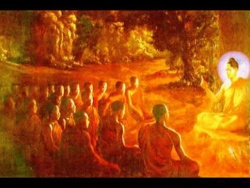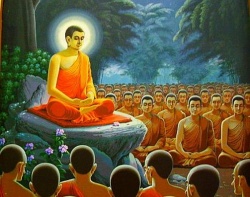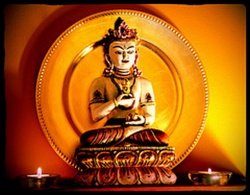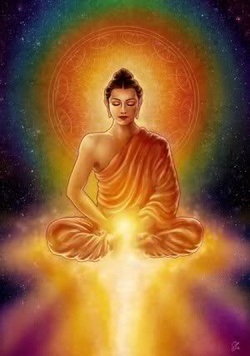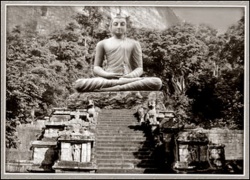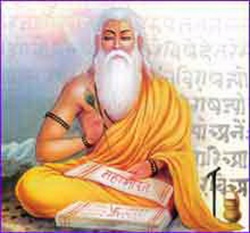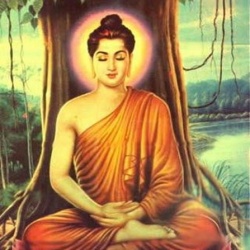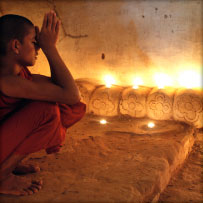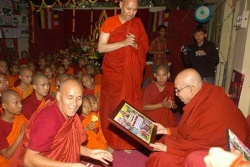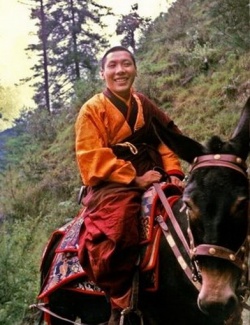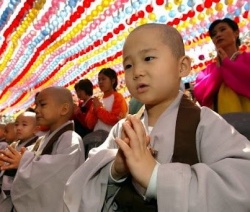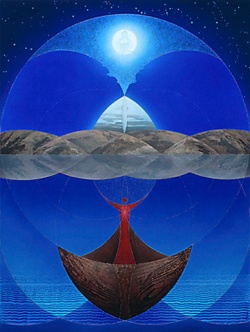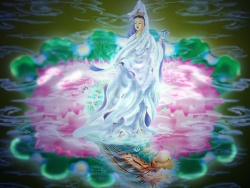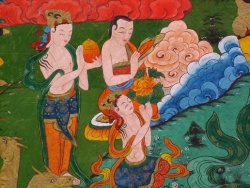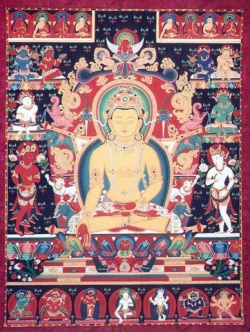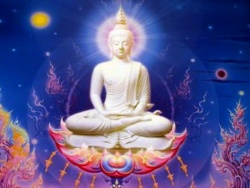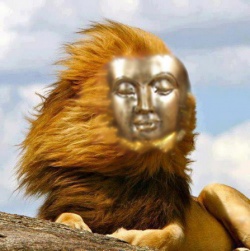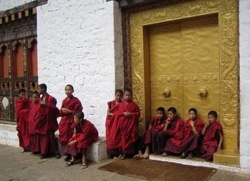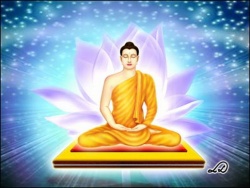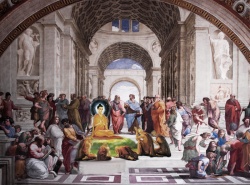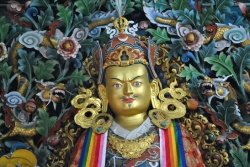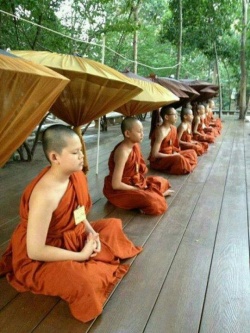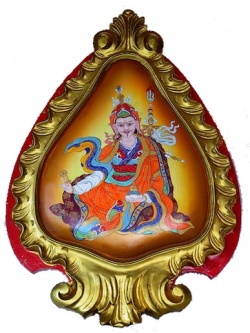Guru
Guru (Devanagari गुरु) is a Sanskrit term for "teacher" or "master", especially in Indian religions. The Hindu guru-shishya tradition is the oral tradition or religious Doctrine transmitted from teacher to student. In the United States, the meaning of "guru" has been used to cover anyone who acquires followers, especially by exploiting their naiveté, due to the inflationary use of the term in new religious movements.
Guru (Skt); bla ma (Tib). Spiritual teacher. The Sanskrit word literally means ‘heavy.’ The Tibetan word ‘bla ma’ (pronounced la ma) means unsurpassed or supreme. A teacher requires specific qualifications to be regarded as a guru. These vary according to the level of practice.
Etymology
- The syllable gu means shadows
- The syllable ru, he who disperses them,
- Because of the Power to disperse darkness
- the guru is thus named.
- — Advayataraka Upanishad 14—18, verse 5
The word guru, a noun, means "teacher" in Sanskrit and in other languages derived from or borrowing words from Sanskrit, such as Hindi, Punjabi, Tamil, Telugu, Kannada, Malayalam, Marathi, Oriya, Bengali, Gujarati and Nepali. The malayalam term Acharyan or Asan are derivered from the Sanskrit word Acharya. It is transliterated in different ways such as Asaan, Ashan, Aasaan etc.
As a noun the word means the imparter of Knowledge (jñāna; also Pali: ñāna). As an adjective, it means 'heavy,' or 'weighty,' in the sense of "heavy with Knowledge," heavy with Spiritual Wisdom, "heavy with Spiritual weight," "heavy with the good qualities of scriptures and realization," or "heavy with a Wealth of Knowledge." The word has its roots in the Sanskrit gri (to invoke, or to praise), and may have a connection to the word gur, meaning 'to raise, lift up, or to make an effort'. Sanskrit guru is cognate with Latin gravis 'heavy; grave, weighty, serious' and Greek βαρύς barus 'heavy'. All Proto-Indo-European root *gʷerə-, specifically from the zero-grade Form *gʷr̥ə-.
A traditional etymology of the term "guru" is based on the interplay between darkness and Light. The guru is seen as the one who "dispels the darkness of Ignorance." In some texts it is described that the syllables gu (गु) and ru (रु) stand for darkness and Light, respectively.
Reender Kranenborg disagrees, stating that darkness and Light have nothing to do with the word guru. He describes this as a folk etymology.
Another etymology of the word "guru" found in the Guru Gita, includes gu as "beyond the qualities" and ru as "devoid of Form", stating that "He who bestows that nature which transcend the qualities is said to be guru". The meanings of "gu" and "ru" can also be traced to the Sutras indicating concealment and its annulment.
In Western Esotericism and the Science of Religion, Pierre Riffard makes a distinction between "occult" and "scientific" etymologies, citing as an example of the former the etymology of 'guru' in which the derivation is presented as gu ("darkness") and ru ('to push away'); the latter he exemplifies by "guru" with the meaning of 'heavy'
Guru in Hinduism
The importance of finding a guru who can impart transcendental Knowledge (vidyā) is emphasised in Hinduism. One of the main Hindu texts, the Bhagavad Gita, is a dialogue between God in the Form of Krishna and his friend Arjuna, a Kshatriya prince who accepts Krishna as his guru on the battlefield, prior to a large battle. Not only does this dialogue outline many of the ideals of Hinduism, but their relationship is considered an ideal one of Guru-Shishya. In the Gita, Krishna speaks to Arjuna of the importance of finding a guru:
In the sentence mentioned above, guru is used more or less interchangeably with satguru (literally: true teacher) and satpurusha. Compare also Swami. The Disciple of a guru is called a śiṣya or chela. Often a guru lives in an ashram or in a gurukula (the guru's household), together with his disciples. The lineage of a guru, spread by disciples who carry on the guru's message, is known as the guru Parampara, or disciplic succession.
The role of the guru continues in the original sense of the word in such Hindu traditions as the Vedānta, yoga, Tantra and Bhakti schools. Indeed, it is now a standard part of Hinduism that a guru is one's Spiritual guide on earth. In some more Mystical traditions it is believed that the guru could awaken dormant Spiritual Knowledge within the pupil. The act of doing this is known as shaktipat.
In Hinduism, the guru is considered a respected person with saintly qualities who enlightens the Mind of his or her Disciple, an educator from whom one receives the initiatory Mantra, and one who instructs in Rituals and religious ceremonies. The Vishnu Smriti and Manu Smriti regard the teacher and the mother and father as the most Venerable Influences on an individual.
In Indian culture, a person without a guru or a teacher (Acharya) was once looked down on as an orphan or unfortunate one. The word anatha in Sanskrit means "the one without a teacher." An Acharya is the giver of gyan (Knowledge) in the Form of shiksha (instruction). A guru also gives diksha initiation which is the Spiritual Awakening of the Disciple by the grace of the guru. Diksha is also considered to be the procedure of bestowing the divine powers of a guru upon the Disciple, through which the Disciple progresses continuously along the path to divinity.
The concept of the "guru" can be traced as far back as the early Upanishads, where the idea of the Divine Teacher on earth first manifested from its early Brahmin associations.
The guru-shishya tradition
- See also:Guru-shishya tradition
The guru-shishya tradition is the transmission of teachings from a guru (teacher, गुरू) to a 'śiṣya' (Disciple, िशष्य). In this relationship, subtle and advanced Knowledge is conveyed and received through the student's respect, commitment, devotion and obedience. The student eventually masters the Knowledge that the guru embodies.
The dialogue between guru and Disciple is a fundamental component of Hinduism, established in the oral traditions of the Upanishads (c. 2000 BC). The term Upanishad derives from the Sanskrit words upa (near), ni (down) and şad (to sit) — "sitting down near" a Spiritual teacher to receive instruction. Examples include the relationship between Krishna and Arjuna in the Mahabharata (Bhagavad Gita), and between Rama and Hanuman in the Ramayana. In the Upanishads, the guru-Disciple relationship appears in many settings (a husband answers a wife's questions about immortality; a teenage boy is taught by Yama, who is Death personified, etc.) Sometimes the sages are female, and sometimes the instruction is sought by kings.
In the Vedas, the brahmavidya or Knowledge of Brahman is communicated from guru to shishya orally.
The word Sikh is derived from the Sanskrit shishya
Assessing a Disciple
At the beginning of the Upadesasahasri Samkara provides a list of criteria by which the guru assesses prospective disciples. It is clear that Samkara did not regard the examination of candidates as a mere formality. The guru assesses the applicant using the following criteria: the candidate is not attached to anything Impermanent; he has renounced the desire for a son; he has no desire for Wealth; he is at peace with himself, master of his senses and compassionate. In addition, the guru checks the applicant's Caste, behaviour, Knowledge of Veda and even earlier generations of his family.
Knowledge was not regarded as a universal right, as it often is today. Access to Knowledge via the guru was the privilege of a very small minority. It was the norm to transmit Knowledge in the erudite Language of Sanskrit without translation. Mastery of Sanskrit was therefore essential. What was taught by guru was the universal reality of Brahman, but access to this Knowledge was highly restricted. Ultimate Knowledge was founded on the Veda, and the guru followed the instruction of the texts: no one belonging to the sudra Caste was allowed access. Women and foreigners were also excluded.
Classification of gurus
In his book about neo-Hindu movements in (for example Wilmer) the Netherlands, Kranenborg distinguishes four types of gurus in India:
- the Spiritual advisor for higher Caste Hindus who also performs traditional Rituals and who is not connected to a temple (thus not a priest);
- the Enlightened master who derives his authority from his experience, such as achieving Enlightenment. This type appears in Bhakti movements and in Tantra and asks for unquestioning obedience, and can have Western followers. Westerners can even become one, as have, for example Andrew Cohen, and Isaac Shapiro.
- the Avatar, a guru who considers himself to be an incarnation of God, God-like, or an instrument of God, or who is considered as such by others.
- A "guru" in the Form of a book i.e. the Guru Granth Sahib in the Sikh Religion;
Attributes of guru
Gurus of several Hindu denominations are often referred to as Satgurus.
In the Upanishads, five signs of satguru (true guru) are mentioned
In the presence of the satguru; Knowledge flourishes (Gyana raksha); Sorrow diminishes (Dukha kshaya); Joy wells up without any reason (Sukha aavirbhava); Abundance dawns (Samriddhi); All talents manifest (Sarva samvardhan).
According to the Indologist Georg Feuerstein, the preceptors were traditionally treated with great reverence, granted excessive authority, and identified with the transcendental Reality. He writes that partly to counterbalance this deification, some Hindu schools began to emphasize that the real teacher is the transcendental Self.
The Shiva Samhita, a late medieval text on Hatha yoga, enshrines the figure of the guru as essential for Liberation, and asserts that the Disciple should give all his or her property and livestock to the guru upon diksha (initiation).
The Vishnu Smriti and Manu Smriti regard the Acharya (teacher/guru), along with the mother and the father, as the most Venerable individuals. The mother and father are the first "guru," the Spiritual guru is the second.
The Mundaka Upanishad says that in order to realize the supreme godhead, one should surrender one's self before the guru who knows the secrets of the Vedas.
On the role of the guru, Swami Sivananda asks: "Do you realize now the sacred significance and the supreme importance of the Guru's role in the Evolution of man? It was not without reason that the India of the past carefully tended and kept alive the lamp of Guru-Tattva. It is therefore not without reason that India, year after year, age after age, commemorates anew this ancient concept of the Guru, adores it and pays homage to it again and again, and thereby re-affirms its belief and allegiance to it. For, the true Indian knows that the Guru is the only guarantee for the individual to transcend the bondage of sorrow and Death, and experience the Consciousness of the Reality."
Some scriptures and gurus have warned against false teachers, and have recommended that the Spiritual seeker test the guru before accepting him. Some have given criteria on how to distinguish false from genuine ones:
- The Advaya Taraka Upanishad states that the true teacher is well-versed in the Vedas, is a devotee of Vishnu, is free from envy, knows yoga and is intent upon it, and always has the nature of yoga. Also that a person who is equipped with devotion to the teacher, has Knowledge of the Self and possesses the above characteristics may be designated as a guru.
- The Maitrayaniya Upanishad warns against false teachers who may deceive the naive.
- The Kula-Arnava-Tantra states that there are many gurus who may rob the Disciple's Wealth but few who can remove the Disciple's Afflictions.
- Swami Vivekananda said that there are many incompetent gurus, and that a true guru should understand the spirit of the scriptures, have a pure character and be free from sin, and should be selfless, without desire for money and Fame.
- Mirinalini Mata, a direct Disciple of Yogananda, said that a true guru should be humble (Self-Realization Fellowship 1978, Cassette No 2402)
- Sathya Sai Baba said in a discourse (Sathya Sai Speaks, vol I, p. 197) that the hunt for rich disciples who can be fleeced has become a tragicomedy, and said in the booklet Sandeha Nivarini that the seeker should test the guru by assessing whether his words are full of Wisdom, and whether he puts into practice what he preaches.
- Saibaba The Master by Acharya Ekkirala Bharadwaja an in depth study of Shirdi Sai as a guru insists that one must follow the way of reading Life histories of saints and it is the saints which will show us the correct guru when we are ready and capable of serving a guru. In Sufi-ism which revolves around Aulias(Saints), a Disciple prays a Sufi-saint at his tomb, until the saint appears in a dream to the Disciple and shows him the correct and living guru to go and serve. This is claimed as the Most secure way of entering a Guru-Shishya Parampara. Guru Charitra by Acharya Ekkirala Bharadwaja explains it in more detail.
Rituals
Guru Purnima is the day when the Disciple wakes up and expresses Gratitude. The purpose of the Guru Purnima (or Poornima) celebration is to review the preceding year to see how much one has progressed in Life, to renew one's determination, and to focus on one's progress on the Spiritual path.
Guru Puja (literally "worship of the guru") the practice of worshiping the guru through the making of offerings and requesting inspiration from the guru. Vows and commitments made by the Disciple or shishya, which might have lost their strength, are renewed.
Guru Bhakti (literally "devotion to the guru") is considered important in many schools and sects.
In modern Hinduism
Some Hindu denominations like BAPS Swaminarayan Sanstha hold that a personal relationship with a living guru, revered as the embodiment of God, is essential in seeking moksha. The guru is the one who guides his or her Disciple to become jivanmukta, the liberated soul able to achieve salvation in his or her lifetime.
There is an understanding in some forms of Hinduism that if the devotee were presented with the guru and God, first he would pay respect to the guru, since the guru had been instrumental in leading him to God. Some traditions claim "Guru, God and Self" (Self meaning soul, not personality) are one and the same. Saints and poets in India have expressed the following views about the relationship between Guru and God:
Best known representatives include Maha MahaRishi Paranjothiar (Kundalini Yoga), Maharishi Mahesh Yogi (Transcendental Meditation), Sai Baba, A. C. Bhaktivedanta Swami Prabhupada, Balyogeshwar (also known as "Guru Maharaj Ji", "Maharaji", and "Prem Rawat") (Divine Light Mission), and Rajneesh (Sannyasis)
Guru in Buddhism
In the Theravada Buddhist tradition, the teacher is a valued and honoured mentor worthy of great respect and is a source of inspiration on the path to Enlightenment, however the teacher is not generally considered to be a guru but rather a Spiritual friend or Kalyāṇa-mittatā.
In the Tibetan tradition, the guru is seen as The Buddha, the very root of Spiritual realization and the basis of the path. Without the teacher, it is asserted, there can be no experience or Insight. In Tibetan texts, great emphasis is placed upon praising the virtues of the guru. Blessed by the guru, whom the Disciple regards as a Bodhisattva, or the embodiment of Buddha, the Disciple can continue on the way to experiencing the true nature of reality. The Disciple shows great Appreciation and devotion for the guru, whose Blessing is the last of the four foundations of Vajrayana Buddhism.
The Dalai Lama, speaking of the importance of the guru, said: "Rely on the teachings to evaluate a guru: Do not have blind Faith, but also no blind Criticism." He also observed that the term 'living Buddha' is a translation of the Chinese words huo fuo. In Tibetan, he said, the operative word is Lama which means 'guru'. A guru is someone who is not necessarily a Buddha, but is heavy with Knowledge.
Tantric teachings include the practice of Guru yoga, visualizing the guru and Making Offerings praising the guru. The guru is known as the Vajra (literally "diamond") guru. Initiations or Ritual empowerments are necessary before the student is permitted to practise a particular Tantra. The guru does not perform initiation as an individual, but as the person's own Buddha-nature reflected in the personality of the guru. The Disciple is asked to make Samaya or vows and commitments which preserve the Spiritual link to the guru, and is told that to break this link is a serious downfall.
There are Four Kinds of Lama (Guru) or Spiritual teacher (Tib. Lama nampa shyi) in Tibetan Buddhism:
- gangzak gyüpé Lama — the individual teacher who is the holder of the lineage
- gyalwa ka yi Lama — the teacher which is the word of the Buddhas
- nangwa da yi Lama — the symbolic teacher of all Appearances
- rigpa dön gyi Lama — the absolute teacher, which is rigpa, the true nature of Mind
Guru in Sikhism
The Sikh Gurus were fundamental to the Sikh Religion, however the concept in Sikhism differs from other usages.
Sikhism is derived from the Sanskrit word shishya, or Disciple and is all about the relationship between the teacher and a student. The core beliefs of Sikhism are of belief in the One God and in Ten Gurus, enshrined in Guru Granth Sahib, the Sikh holy book. The concept of Guru in Sikhism stands on two pillars i.e. Miri-Piri. 'Piri' means Spiritual authority and 'Miri' means temporal authority. Therefore, Guru in Sikhism is a teacher-leader. Traditionally, the Spiritual authority in Sikhism has always been the word and which is still preserved in the Guru Granth Sahib. And for temporal authority, as the word passed through 10 mortal bodies and finally into the collective corporate Body known as the Khalsa till eternity, kept changing with finally been vested in the Khalsa when Guru Gobind Singh, the 10th Guru, merged into it.
Sri Guru Nanak Dev Ji, the first guru of Sikhism, was opposed to the Caste system prevalent in India in his time, and he accepted Hindus, Muslims and people from other religions as disciples. His followers referred to him as the Guru (teacher). Before he left the World he designated a new Guru to be his successor and to lead the Sikh community. This procedure was continued till March 30, 1699. In addition to the original ten teachers, the Guru Granth Sahib, their holy book, and the Khalsa was made the eleventh perpetual Guru of the Sikhs. Together they make up the eleven Gurus of Sikhism
Succession and lineage (Parampara)
The word Parampara (Sanskrit परम्परा) denotes a long succession of teachers and disciples in traditional Indian culture. The Hinduism Dictionary defines Parampara is "the line of Spiritual gurus in authentic succession of initiation; the chain of Mystical Power and authorized continuity, passed from guru to guru." In Sanskrit, the word literally means: Uninterrupted series of succession.
The Guru (teacher) Shishya (Disciple) Parampara or guru Parampara, occurs where the Knowledge (in any field) is passed down undiluted through the succeeding generations. It is the traditional, residential Form of education, where the Shishya remains and learns with his Guru as a family member. The domains may include Spiritual, artistic (Kalā कला such as music or dance) or educational.
David C. Lane, a professor of sociology, and, since 2005, an ex-member and critic of Radha Soami Satsang Beas, argued in 1997 that based on his research of the Radha Soami movement that few gurus have a flawless and well-documented lineage, and that there is quite often conflict between different disciples claiming to be the only legitimate successor of their guru
Western perspective
As an alternative to established religions, some people in Europe and the USA who were not of Indian extraction have looked up to Spiritual guides and gurus from India, seeking them to provide them answers to the meaning of Life, and to achieve a more direct experience free from intellectualism and philosophy. Gurus from many denominations traveled to Western Europe and the USA and established followings. One of the first to do so was Swami Vivekananda who addressed the World Parliament of Religions assembled in Chicago, Illinois in 1893.
In particular during the 1960s and 1970s many gurus acquired groups of young followers in Western Europe and the USA. According to the American sociologist David G. Bromley this was partially due to the repeal of the Chinese Exclusion Act in 1965 which permitted Asian gurus entrance to the USA. According to the Dutch Indologist Albertina Nugteren, the repeal was only one of several factors and a minor one compared with the two most important causes for the surge of all things 'Eastern': the post-War cross-cultural mobility and the general dissatisfaction with established Western values. According to the professor in sociology Stephen A. Kent at the University of Alberta and Kranenborg (1974), one of the reasons why in 1970s young people including hippies turned to gurus was because they found that Drugs had opened for them the existence of the transcendental or because they wanted to get high without Drugs.
According to Kent, another reason why this happened so often in the USA then, was because some anti-Vietnam War protesters and political activists became worn out or disillusioned of the possibilities to change society through political means, and as an alternative turned to religious means. Some gurus and the groups they lead attracted opposition. One example of such group was the Hare Krishna movement (ISKCON) founded by A.C. Bhaktivedanta Swami Prabhupada in 1966, many of whose followers voluntarily accepted the demandingly ascetic lifestyle of Bhakti yoga on a full-time basis, in stark contrast to much of the popular culture of the time.
According to Kranenborg (1984), Jesus fits the Hindu definition and characteristics of a guru
Gurus in the West
Gurus who established a discipleship or who are/were Spiritual leaders of notable organizations in Western countries include:
- "Gnanavallal Paranjothi Mahan" Simplified Kundalini Meditation By Universal Peace Sanctuary.
- "Amma" Mata Amritanandamayi Devi Parliament of the World's Religions, International Advisory Committee Member
- Tenzin Gyatso, 14th Dalai Lama
- Chögyam Trungpa Rinpoche a Lama (Tibetan Buddhist religious teacher).
- Jetsunma Ahkon Lhamo the first western woman to be recognized and enthroned as a Tulku in Tibetan Buddhism.
- Maharishi Mahesh Yogi, founder of Transcendental Meditation (TM), brought his message to the West in 1959.
- Meher Baba, who stated that he was the Avatar of the Age and God in human Form, traveled to the west numerous times in the 1930s and 1950s and had many western followers.
- Swami Muktananda, founder of Siddha Yoga path and the SYDA Foundation.
- Neem Karoli Baba Also known as Maharaj-ji. After Ram Dass' experience in the 1960s in India with Maharaj-ji, he introduced Westerners to Neem Karoli Baba in his book "Be Here Now"
- Paramahansa Yogananda settled in the USA and wrote the book Autobiography of a Yogi
- A.C Bhaktivedanta Swami Prabhupada who founded the International Society for Krishna Consciousness (the 'Hare Krishnas') in New York in 1965, an organization following the Gaudiya Vaishnava tradition of Hinduism.
- Prem Rawat was known as Guru Maharaj Ji until he dropped the title "guru" from his name in 1980.
- Osho (Bhagwan Shree Rajneesh) settled temporarily in the USA.
- Sathya Sai Baba never went to Europe or the USA but acquired a substantial number of followers there.
- Sadhguru Jaggi Vasudev founder of Isha Foundation and the Isha Yoga Centre has a strong volunteer force in India, US and Lebanon.
- Sant Sri Asaramji Bapu founder of Sri Yog Vedanta Sewa Samithi.
- Sri Sri Ravi Shankar founder of the Art of Living Foundation.
- Sri Aurobindo
- Sri Chinmoy
- Swami Parthasarathy
- Thich Nhat Hanh Buddhist guru originally from Vietnam and now settled in France.
- Ruchira Adi Da Samraj Born in the US founded the new Tradition of Adidam, based on Guru Devotee Relationship
- Muhammad Raheem Bawa Muhaiyaddeen was a revered Sufi saint from the island of Sri Lanka who shared his Knowledge and experience with people of every race and Religion and from all parts of the World.
- Nirmala Srivastava founder of Sahaja Yoga, lived in the United Kingdom for many years.
- Reginald Ray, vajracarya of Dharmaocean, senior student of Chögyam Trungpa
- Satguru Sivaya Subramuniyaswami (1927–2001), founder of the Kauai Aadheenam and of the Hinduism Today Magazine.
- Sirio Carrapa, one of the successors of Kirpal Singh and Ajaib Singh (Sant Mat tradition).
- Shri Gurudev Amritji - Yogi Amrit Desai Founder of Kripalu Center and of Amrit Yoga Institute.
- Sri Sri Sri Ganapathy Sachidananda Swamiji Founder of Datta peetam has many followers around the World.
Viewpoints
Gurus and the Guru-shishya tradition have been criticized and assessed by secular scholars, theologians, anti-cultists, skeptics, and religious philosophers.
- Jiddu Krishnamurti, groomed to be a World Spiritual teacher by the Leadership of the Theosophical Society in the early part of the 20th century, publicly renounced this role in 1929 while also denouncing the concept of gurus, Spiritual leaders, and teachers, advocating instead the unmediated and direct Investigation of reality.
- U. G. Krishnamurti, [no relation to Jiddu], sometimes characterized as a "Spiritual anarchist", denied both the value of gurus and the existence of any related worthwhile "teaching".
- Dr. David C. Lane proposes a checklist consisting of seven points to assess gurus in his book, Exposing Cults: When the Skeptical Mind Confronts the Mystical. One of his points is that Spiritual teachers should have high standards of Moral conduct and that followers of gurus should interpret the behavior of a Spiritual teacher by following Ockham's razor and by using common sense, and, should not naively use Mystical explanations unnecessarily to explain immoral behavior. Another point Lane makes is that the bigger the claim a guru makes, such as the claim to be God, the bigger the chance is that the guru is unreliable. Dr. Lane's fifth point is that self-proclaimed gurus are likely to be more unreliable than gurus with a legitimate lineage.
- Highlighting what he sees as the difficulty in understanding the guru from Eastern tradition in Western society, Dr. Georg Feuerstein, a well-known German-American Indologist, writes in the article Understanding the Guru from his book The Deeper Dimension of Yoga: Theory and practice:"The traditional role of the guru, or Spiritual teacher, is not widely understood in the West, even by those professing to practice Yoga or some other Eastern tradition entailing discipleship. [...] Spiritual teachers, by their very nature, swim against the stream of conventional values and pursuits. They are not interested in acquiring and accumulating material Wealth or in competing in the marketplace, or in pleasing egos. They are not even about Morality.
Typically, their message is of a radical nature, asking that we live consciously, inspect our motives, transcend our egoic passions, overcome our Intellectual blindness, live peacefully with our fellow humans, and, finally, realize the deepest core of Human nature, the Spirit. For those wishing to devote their time and energy to the pursuit of conventional Life, this kind of message is revolutionary, subversive, and profoundly disturbing.". In his Encyclopedic Dictionary of Yoga (1990), Dr. Feuerstein writes that the importation of yoga to the West has raised questions as to the appropriateness of Spiritual discipleship and the legitimacy of Spiritual authority.
- A British professor of psychiatry, Anthony Storr, states in his book, Feet of Clay: A Study of Gurus, that he confines the word guru (translated by him as "revered teacher") to persons who have "special Knowledge" who tell, referring to their special Knowledge, how other people should lead their lives. He argues that gurus share common character traits (e.g. being loners) and that some suffer from a mild Form of schizophrenia. He argues that gurus who are authoritarian, paranoid, eloquent, or who interfere in the private lives of their followers are the ones who are more likely to be unreliable and dangerous. Storr also refers to Eileen Barker's checklist to recognize false gurus.
He contends that some so-called gurus claim special Spiritual insights based on personal revelation, Offering new ways of Spiritual development and paths to salvation. Storr's Criticism of gurus includes the possible risk that a guru may exploit his or her followers due to the authority that he or she may have over them, though Storr does acknowledge the existence of morally superior teachers who refrain from doing so. He holds the view that the idiosyncratic belief systems that some gurus promote were developed during a period of psychosis to make sense of their own minds and perceptions, and that these belief systems persist after the psychosis has gone. Storr applies the term "guru" to figures as diverse as Jesus, Muhammad, Buddha, Gurdjieff, Rudolf Steiner, Carl Jung, Sigmund Freud, Jim Jones and David Koresh.[42] The Belgian Indologist Koenraad Elst criticized Storr's book for its avoidance of the term prophet instead of guru for several people. Elst asserts that this is possibly due to Storr's pro-Western, pro-Christian cultural bias.
- Rob Preece, a psychotherapist and a practicing Buddhist, writes in The Noble Imperfection that while the teacher/Disciple relationship can be an invaluable and fruitful experience, the process of relating to Spiritual teachers also has its hazards. He writes that these potential hazards are the result of naiveté amongst Westerners as to the nature of the guru/devotee relationship, as well as a consequence of a lack of understanding on the part of Eastern teachers as to the nature of Western psychology.
Preece introduces the notion of transference to explain the manner in which the guru/Disciple relationship develops from a more Western psychological perspective. He writes: "In its simplest sense transference occurs when unconsciously a person endows another with an attribute that actually is projected from within themselves." In developing this concept, Preece writes that, when we transfer an inner quality onto another person, we may be giving that person a Power over us as a consequence of the projection, carrying the potential for great Insight and inspiration, but also the potential for great danger: "In giving this Power over to someone else they have a certain hold and influence over us it is hard to resist, while we become enthralled or spellbound by the Power of the archetype".
- According to a professor of religious studies at Dawson College in Quebec, Susan J. Palmer, the word guru has acquired very negative connotations in France.
- The psychiatrist Alexander Deutsch performed a long-term observation of a small cult, called The Family (not to be confused with Family International), founded by an American guru called Baba or Jeff in New York in 1972, who showed increasingly schizophrenic behavior. Deutsch observed that this man's mostly Jewish followers interpreted the guru's pathological mood swings as expressions of different Hindu deities and interpreted his behavior as holy madness, and his cruel deeds as punishments that they had earned. After the guru dissolved the cult in 1976, his Mental condition was confirmed by Jeff's retrospective accounts to an author.
- Jan van der Lans (1933–2002), a professor of the psychology of Religion at the Catholic University of Nijmegen, wrote, in a book commissioned by the Netherlands based Catholic Study Center for Mental Health, about followers of gurus and the potential dangers that exist when personal contact between the guru and the Disciple is absent, such as an increased chance of idealization of the guru by the student (myth making and deification), and an increase of the chance of false mysticism. He further argues that the deification of a guru is a traditional element of Eastern Spirituality, but, when detached from the Eastern cultural element and copied by Westerners, the distinction between the person who is the guru and that which he symbolizes is often lost, resulting in the relationship between the guru and Disciple degenerating into a boundless, uncritical personality cult.
- In their 1993 book, The Guru Papers, authors Diana Alstad and Joel Kramer reject the guru-Disciple tradition because of what they see as its structural defects. These defects include the authoritarian control of the guru over the Disciple, which is in their view increased by the guru's encouragement of surrender to him. Alstad and Kramer assert that gurus are likely to be hypocrites because, in order to attract and maintain followers, gurus must present themselves as purer than and superior to ordinary people and other gurus.
- According to the journalist Sacha Kester, in a 2003 article in the Dutch newspaper De Volkskrant, finding a guru is a precarious matter, pointing to the many holy men in India and the case of Sathya Sai Baba whom Kester considers a swindler. In this article he also quotes the book Karma Cola describing that in this book a German economist tells author Gita Mehta, "It is my opinion that quality control has to be introduced for gurus. Many of my friends have become crazy in India". She describes a comment by Suranya Chakraverti who said that some Westerners do not believe in Spirituality and ridicule a true guru. Other westerners, Chakraverti said, on the other hand believe in Spirituality but tend to put Faith in a guru who is a swindler.
Notable scandals and controversies
Some notable scandals and controversies regarding gurus or the groups that they founded are:
The lifestyle of Osho (Bhagwan Shree Rajneesh) with his 93 Rolls Royces at his disposal (though as a gift from his followers), a bioterrorist attack at The Dalles, Oregon by some of his followers, the group's successful effort to take control of the city of Antelope, Oregon, his unusual teachings that contradicted both traditional Morality and Hindu norms, the group therapy sessions with little restraints, and the liberal sexual freedom that he promoted. The Sarin gas attack on the Tokyo subway by Aum Shinrikyo founded by the guru Shoko Asahara in Japan.
Accusations of sexual abuse and false miracles performed by Sathya Sai Baba that resulted in a front page article in the magazine India Today, questions in the British and European parliaments, and critical TV documentaries produced by the BBC and Danish Radio that were aired in the United Kingdom, Canada, Denmark and Australia. Sathya Sai Baba dismissed the accusations as the mere "cawing of crows.". The Karmapa controversy in which the recognition of the 17th Karmapa of Tibetan Buddhism is contested by candidates having been proposed by different authorities, and there is deep division among followers all over the World, with each side accusing the other of lying and wrongdoing. Lama Osel Tendzin (from the Shambhala Buddhism lineage) had unprotected sex with some of his students while he was HIV positive; one of the young men involved later contracted AIDS and died, after passing the infection on to a girlfriend.
Source
See Also
- (The Sutra of the Master of Healing) (Bhaisajayaguru-Vaidurya-Prabhasa Tathagata)
- 128 Guru Yoga of Padmasambhava and Adzom Drugpa
- 3RD BARDOR RINPOCHE (1949-2021): Life-story, Swift Re-birth Prayer by 17th Karmapa, Letters of Condolence, Letter from 16th Karmapa and Self-Arisen Guru Rinpoche
- 50 Stanzas on Devotion to the Guru (Foreword)
- 50 Stanzas on Devotion to the Guru - Foreword
- 50 Verses of Guru Devotion
- 50 Verses on Guru Devotion By Indian Master Ashvagosha
- A Brief Meditation-Recitation on Guru Medicine Buddha
- A Brief Sadhana of Medicine Guru Buddha
- A Brief Sadhana of Medicine Guru Buddha/See Also Section
- A Buddhist asks Sadhguru a Puzzling Question
- A Commentary on Calling the Guru from Afar
- A Garland of Vajra Gems - The Life and Liberation of the Guru by Jamgön Kongtrul
- A Guru Yoga That Brings The Dharmakaya Onto The Path
- A Journey Through the Guru’s Name Mantra
- A Prayer to Guru Rinpoche That Spontaneously Fulfils All Wishes From the Extremely Secret Assembly of Sugatas
- A Prayer to the Guru that Swiftly Fulfills All Wishes
- A Profound and Concise Guru Yoga by Chatral Rinpoche
- A Shortcut to the Siddhi of Immortality Guru Yoga of Union with the Three Deities of Long Life
- A Simple Ritual for Daily Practice of Guru Yoga
- A Storehouse of Jewel’s Treasure: A Meditation Manual of the Whispered Lineage of Gaden on the Profound Path of the Guru Yoga of Hundred Gods’ Joyful Realm by Kyabje Pabongka Rinpoche
- A Synopsis of Guru Padmasambhava’s Life
- A Talk on Guru Devotion
- A Teaching on Guru Rinpoche's Supplication That All Thoughts Be Self-Liberated
- A True Account of An Accomplished Practitioner of the Vajra Guru Mantra in Recent Times
- Abandoning arrogance when taking orders from your guru
- Abandoning disturbing your guru’s mind
- Abhinavagupta's Portrait of a Guru: Revelation and Religious Authority in Kashmir
- About Guru Rinpoche
- Absolute Guru; Dharma vs. Samsaric Happiness
- Absolute guru
- Absolute guru (Tib: don-dam lama)
- Adi Guru
- Adiyoga - Great master of Oddiyana - Great Masters of Nyingma Lineage - Calling our guru from far
- Advice Regarding Gurus By Ven. René Feusi
- Advice about what to do when in the guru’s field of sight
- Advice about what to do when in the guru’s range of hearing
- Advice from Guru Rinpoche
- Advice on Calling the Guru from Afar
- Although your realization is equal to that of the buddhas', make offerings to the Three Jewels. Guru Rinpoche
- American Guru Andrew Cohen & Allegations of Abuse
- An Introduction to the Chanting - Lineage of the Guru Puja
- Ananda Maitreya Mahanayaka Thera Abhidhaja Maharatthaguru Aggamaha
- And Guru Rinpoche himself promised in his own words
- And never chatter idly or speak in excess (or too loudly) within range of (your guru’s) hearing
- Arrange the seat for Medicine Guru Buddha with the following stanza
- Attributes of Guru Rinpoche
- Aṣṭabhaiṣajy aguru
- Baishajyaguru
- Being true to the true guru
- Bendigo - Suffering of higher realms. Guru devotion- how precious the guru is (Video)
- Benzar Guru
- Benzar guru
- Bhai ṣajy aguru
- Bhaisajya-guru
- Bhaisajya-guru-vaidurya-prabhasa
- Bhaisajya-guru-vaidurya-prabhasa/See Also Section
- Bhaisajyaguru
- Bhaisajyaguru's
- Bhaisajyaguru/See Also Section
- Bhaisajyaguru: The Medicine Buddha
- Bhaisajyaguru - The Medicine Buddha - Visible Mantra
- Bhaisajyaguru - Wikipedia
- Bhaisajyaguru Buddha
- Bhaisajyaguru Buddha/See Also Section
- Bhaisajyaguru Lapis Lazuli Tathagata
- Bhaisajyaguru buddha
- Bhaisajyaguru’s
- Bhaishajua-guru
- Bhaishajyaguru
- Bhaishajyaguru Vaiduryaprabha
- Bhaishajyarajaguru
- Bhaiṣajy aguru
- Bhaiṣajya Guru
- Bhaiṣajyaguru
- Bhaiṣajyaguru-Vaiḍūryaprabhārāja
- Bhaiṣajyaguru-vaiḍūryaprabharāja
- Bhaiṣajyaguru (Sanskrit: भैषज्यगुरु, Chinese: 藥師佛,
- Bhaiṣajyaguru - the Medicine Buddha Mantra
- Bhaiṣajyaguru - the Medicine Buddha Mantra/See Also Section
- Bhaiṣajyaguru sūtra
- Bhaiṣajyaguru vaiḍūryaprabha tathāgata
- Bhaiṣajyagurubuddha
- Bhaiṣajyagurusūtra
- Bhaiṣajyaguruvaidūryaprabharāja Sūtra
- Bhaiṣajyaguruvaiḍūryaprabhārāja
- Bhaiṣajyaguruvaiḍūryaprabhārāja Sūtra
- Bhaysajaguru
- Bhutan’s Zangdog Pelri Temples: Paradises of Guru Rinpoche
- Biography, Guru Yoga, and Prayers for His Swift Return
- Blessings of Mahāguru Prayer – Understanding of the True Nature of Mind
- Buddhism:How to find a Guru?
- Bundasheri Tulku Guru Deva
- CLEAR RAIN MELTING FROZEN SNOW, THE GURU’S BLESSINGS: MEETING HIS MOTHER, LIFE AFTER PRISON, MAHASIDDHA KARMA NORBU, FINDING KHENPO MUNSEL AND GETTING MONASTIC VOWS. Guru Stories (Part 4) by 8th Garchen Rinpoche
- Calling the Guru From Afar and Practicing Guru Devotion with the Nine Attitudes
- Calling the Guru from
- Calling the Guru from Afar
- Can Work be Used as Sadhana? Sadhguru VIDEO
- Celebrate the birth of Guru Padmasambhava at the Hemis
- Celebrating Guru Padmasambhava – the one who was never born and never died
- Chanting Heart Mantra of Guru and Visualization Heart Mantra of Guru Lin
- Characteristics of those unsuitable to be gurus
- Chenrezig as the Sambhogakaya Guru Rinpoche as the Nirmanakaya
- Chinese version Guru Mantra teaching
- Chronotopic Narratives of Seven Gurus and Eleven Texts: A Medieval Buddhist Community of Female Tāntrikas in the Swat Valley of Pakistan*
- Cloud Banks of Blessings: A Prayer Recounting the Eleven Deeds of the Life and Liberation of the Guru from Uḍḍiyāna
- Cloud Banks of Blessings: Prayer to Guru Padmasambhava by the Fifth Dalai Lama
- Cloudbanks of the Two Accumulations A Gathering Offering Including The Six Vajra Lines Supplication To Be Practiced With Any Guru Sadhana
- Collection of thoughts of a teacher-guru
- Commentaries on: The Six Session Guru Yoga, The Short Sadhana of the Solitary Hero Vajrabhairava and The Short Sadhana of Vajrayogini by Kyabje Gelek Rinpoche
- Compassion and devotion qualities of an authentic guru and disciple– advice from Milarepa and Thangtong Gyalpo
- Concise Offering of the Body From the Root Text of the Heart Accomplishment of the Guru Tukdrup, The Essential Manual of Oral Instructions (Shaldam Nyingjang)
- Conclusion – Getting genuine Guru’s blessings like rain melting snow
- Consort of Guru Padmsambhav
- Consort of Guru Rinpoche
- Consorts of the gurus
- Continuous Rain of Nectar on the Sprouts of the Four Kayas Guru Yoga
- Conventional guru
- Correctness of being reverent toward a guru
- Cultivating respect for the guru has eight divisions
- Cultivation of Guru Yoga Practice
- Daily Practice of Guru Drakpo by Jamyang Khyentse Chökyi Lodrö
- Dedication for the End of All Guru Yoga Practices
- Dharmaguru
- Disciple of Guru Rinpoche
- Do not be disrespectful to the Guru
- Do prostration three times to Gurus and the Triple Gem, then fold palms together and sincerely recite
- Do prostration three times to Gurus and the Triple Gem, then fold palms together and sincerely recite:
- Doing what the guru says
- Dudjom Rinpoche's Interview about Guru Padmasambhava
- Dzongsar Khyentse, The Guru Drinks Bourbon?
- Early guru yoga, indigenous ritual, and Padmasambhava
- Eight Aspects of Guru Rinpoche
- Eight Manifestations of Guru Padmasambhava
- Eight Manifestations of Guru Rinpoche
- Eight Manifestations of Guru Rinpoche - 3
- Eight Manifestations of Guru Rinpoche - Rigpa Wiki
- Eight Manifistations of Guru Rinpoche
- Eight ‘names’ of the Guru
- Embodiment of all the Buddhas’: Twenty-three short Karmapa Guru Yoga texts by the 15th Karmapa
- Embodiment of devotion through guru yoga
- Empowerment and Teachings on the Eight Manifestations of Guru Rinpoche
- Empowerment from the Guru
- Encountering The Guru
- Enlightened qualities of the guru
- Enthronement: The Ongoing Incarnation Heritage of Guru Rinpoche
- Epitome Of The Great Guru's Biography
- Essence of the Profound Path - A General Visualization for Prayers to Guru Rinpoche
- Explanation, Assumption and Guru Yoga
- Fifty Stanzas of Guru Devotion
- Fifty Stanzas on the Guru
- Fifty Verses Of Guru Devotion
- Fifty Verses of Guru Devotion
- Fifty verses of guru devotion
- First Guru of the Kagyu lineage
- First gurudharma
- First homage to the Root Guru and all Buddhas in all times and directions
- Five principal consorts of Guru Rinpoche
- For Formal Vajrayana Practice: Guru Rinpoche
- Four Cycles of Guru Sadhana
- From The Guru’s Heart Practice: Dispeller of All Obstacles (Lamé Tukdrup Barché Kunsel)
- From “Life of Milarepa”, Part II, Chapter 5 – The Parting from the Guru (tr. Adele Tomlin)
- GURU RINPOCHE DAY TEACHINGS Five Ways of Practicing Guru Yoga
- Gampopa Guru Yoga
- Ganden Lha Gyäma: The Guru Yoga of Tushita’s Deva Host
- Garab Dorje Guru Sādhana
- Garab Dorje Guru Yoga
- Gathering for the Guru
- Gaze of a Guru: Celebrating the Teacher-Student Relationship
- General Practice of Guru Yoga
- Grace of the Presence of Guru Rinpoche
- Great Compassion Mantra in Tibetan Pronunciation According to Guru Chen's Transmission
- Great Guru Padma-sambhava
- Great Homage to the Lineage Root Guru and the Three Treasures represented on the altar using visualization
- Guru's
- Guru's Heart Practice
- Guru's form
- Guru's teachings
- Guru-Padmasambhava collection of Lotsawa House
- Guru-Rimpoche
- Guru-Yoga
- Guru-Yoga and the Seven-Line Prayer
- Guru-deity
- Guru-devotion
- Guru-disciple relationship
- Guru-drag-po
- Guru-ji
- Guru-ju
- Guru-shishya paramparā
- Guru-transmission
- Guru-yoga
- Guru & Avalokiteshvara: Advice on Lam-rim & Tantra
- Guru & Avalokiteshvara: The Remainder of the Text
- Guru - Yoga of Je Tsongkapa
- Guru Bhaju
- Guru C. M. Chen
- Guru Chen
- Guru Chen's
- Guru Chokyi Wangchuk
- Guru Chowang
- Guru Chökyi Wangchuk
- Guru Chöwang
- Guru Cult of Tibetan Tantric Buddhism
- Guru Dance
- Guru Deva Rinpoche
- Guru Devotion
- Guru Devotion: A Brief Introduction for New Students
- Guru Devotion by Shangpa Rinpoche.
- Guru Dhimana Varruchi
- Guru Dongmar Lake
- Guru Dorje Drolo
- Guru Dorje Drolö
- Guru Dradog
- Guru Dragpo
- Guru Dragpo Mantra
- Guru Dragpur
- Guru Drakpo
- Guru Drakpo Padma Sharwari
- Guru Drakpo—the Very Wrathful Guru Rinpoche
- Guru Drakpur
- Guru Garab Dorje
- Guru Ghantal Gompa
- Guru Ghantal Monastery
- Guru Ghantal’s Unusual Mandalas and Hairy Mystery
- Guru Gorakhnath
- Guru Jober
- Guru King of Lapis Light
- Guru Konchok
- Guru Lama Tsongkhapa enters into your heart and becomes completely one with your body, speech, and mind
- Guru Lian Shen
- Guru Lineage
- Guru Loden Chegse
- Guru Loden Chogse
- Guru Loden Chokse
- Guru Loden Choksé
- Guru Mahākāla Pañjaranātha
- Guru Manjunata
- Guru Manjushri Sadhana
- Guru Manjushri Sadhana - White Conch Dharma Center
- Guru Medicine Buddha's
- Guru Nanak
- Guru Nyima Ozer
- Guru Nyima Özer
- Guru Oddiyana
- Guru Oddiyāna Vajradhara
- Guru Orgyen Dorje Chang
- Guru Padma
- Guru Padma Gyalpo
- Guru Padma Jungné
- Guru Padma Sambhava
- Guru Padmakara
- Guru Padmarāja
- Guru Padmasambahva Heart Mantra
- Guru Padmasambhava
- Guru Padmasambhava's
- Guru Padmasambhava's birthday in Hemis
- Guru Padmasambhava: A Profile and His Teachings
- Guru Padmasambhava: Buddha of the Vajrayana
- Guru Padmasambhava: His Miraculous Life Story and the Meaning of His Sadhana
- Guru Padmasambhava; From the heart of Buddha Amitabha
- Guru Padmasambhava and Jurisprudence in Bhutan: Golden Yoke and Silken Knot
- Guru Padmasambhava and Nyingma school of Tibetan Buddhism
- Guru Padmasambhava and his five main Consorts
- Guru Padmasambhava as Dorje Drolo who Took Buddhism to Bhutan
- Guru Padmasambhava in Context: Archaeological and Historical Evidence from Swat/Uddiyana (c. 8th century CE)
- Guru Padmasambhava of Odiyana
- Guru Padmasambhava of Odiyana (Odisha): The Founder of Lamaism in Tibet
- Guru Padmasambhava spoke the following prophecy
- Guru Padmasambhava – Works – eMuseum
- Guru Padmasambhava’s
- Guru Padmasambhava’s Advice to Yeshe Tsogyel from Dākinī Teachings
- Guru Padmasambhava’s Return as Shambhala King
- Guru Padmasambhava’s Return as Shambhala King – Rudra Cakrī
- Guru Padmasambhava’s birthday in Hemis
- Guru Padmasambhava’s supreme disciples
- Guru Pedma Jungnay
- Guru Pema
- Guru Pema's
- Guru Pema Gyalpo
- Guru Pema Jungnay
- Guru Pema Jungne
- Guru Pema Jungné
- Guru Pooja
- Guru Puja
- Guru Puja, Lama Chopa Text
- Guru Puja, Lama Chopa Text – Extra Pages
- Guru Puja, Merit Field
- Guru Puja (Lama Chopa)
- Guru Puja - creating the causes to attain enlightenment
- Guru Puja - tarainstitute
- Guru Puja by Lama Thubten Zopa Rinpoche
- Guru Puja is the Heart Practice I (With Tsog)
- Guru Puja with Tsog
- Guru Puja – Tsog
- Guru Rimpoche
- Guru Rimpoche's Glorious Copper-Coloured Mountain Paradise
- Guru Rin-po-che
- Guru Rinpoche
- Guru Rinpoche's
- Guru Rinpoche's eight emanations
- Guru Rinpoche, Padmasambhava
- Guru Rinpoche, one of the greatest Buddhist yogis of India
- Guru Rinpoche: His Life and Times
- Guru Rinpoche 6 syllable mantra
- Guru Rinpoche Day
- Guru Rinpoche Day Tsok
- Guru Rinpoche Dungdrup
- Guru Rinpoche His Life and Times - Book
- Guru Rinpoche Padmasambhava
- Guru Rinpoche Padmasambhava Mantra
- Guru Rinpoche Practice: Resources - KTD
- Guru Rinpoche Prayer
- Guru Rinpoche Short Prayer for Participants
- Guru Rinpoche Tsog
- Guru Rinpoche Tsok Day
- Guru Rinpoche Yoga
- Guru Rinpoche advised Lady Yeshe Tosgyal how to choose a Yidam — and why there are so many forms:
- Guru Rinpoche and the Introduction of Nyingma Dzogchen
- Guru Rinpoche answers Lady Tsogyal: Should we practice one or many yidams? Is the master or the Yidam more important? Why is it important to practice the yidam deity?
- Guru Rinpoche as emanations of Buddha Sakyamuni
- Guru Rinpoche as the King of Sahor
- Guru Rinpoche by Ken Holmes
- Guru Rinpoche clearly instructs us:
- Guru Rinpoche day
- Guru Rinpoche medicine Buddha(Tibetan: Ogyen Menlha)
- Guru Rinpoche of Medicine
- Guru Rinpoche sadhana
- Guru Rinpoche – A Short Introduction to His Life & Activities
- Guru Rinpoches
- Guru Rinpoches (Padmasambhava) Contribution to Sikkim
- Guru Rinpochey
- Guru Rinpochey's
- Guru Rinpoche’s
- Guru Rinpoche’s Concise Instructions
- Guru Rinpoche’s Exclusive Sacred Places in Bhutan Kunzang Thinley*1
- Guru Rinpoche’s advice for visualizing the deity: a how-to from Padmasambhava with advice from today’s teachers
- Guru Rinpoche’s consort
- Guru Rinpoché
- Guru Rinpoché: his life and times by Ngawang Zangpo
- Guru Rinpoché’s
- Guru Sadhana
- Guru Sadhana for Garab Dorje
- Guru Sangdü—the Dakini Practice
- Guru Senge Dradog
- Guru Sengé Dradrok
- Guru ShAkya bdud 'dul, d.u.
- Guru Shakya Senge
- Guru Shakya Sengé
- Guru Shenrab
- Guru Silamati
- Guru Tashi
- Guru Tsechu puja
- Guru Tsen- Gyad
- Guru Tsen Gye
- Guru Tsen Gyé
- Guru Tsengyé: Eight Manifestations of the Precious Teacher
- Guru Tsewang
- Guru Tso
- Guru Tsokye Dorje
- Guru Tsokyé Dorje
- Guru Vajra
- Guru Vidhyādhara
- Guru Vidyadhara
- Guru Yoga
- Guru Yoga: According to the Preliminary Practice of Longchen Nyingtik by Dilgo Khyentse Rinpoche.
- Guru Yoga: Meditating On or With Your Root Teacher
- Guru Yoga: The Consummate Blessing
- Guru Yoga (Lamai Naljor)
- Guru Yoga Deities
- Guru Yoga Prayer
- Guru Yoga Teaching
- Guru Yoga Texts by the 16th Karmapa
- Guru Yoga That Brings Swift Realisations Practice Guide
- Guru Yoga by Tertön Sogyal Lerab Lingpa
- Guru Yoga of Rigdzin Jigme Lingpa
- Guru Yoga of Tushita’s Deva Host
- Guru Yoga of Vajrasattva
- Guru Yoga practice
- Guru Yoga sadhana
- Guru Yoga
- Guru Zhiwa
- Guru and Disciple
- Guru and Student in the Vajrayana
- Guru and the Path
- Guru as Buddha
- Guru devotion
- Guru devotion - Kadampa Center
- Guru mTshan-brgyad Lhakhang
- Guru of Great Bliss
- Guru of seven Buddhas
- Guru pema siddhi hung
- Guru puja
- Guru pūjā
- Guru pūjās
- Guru rinpoche
- Guru rinpoché
- Guru sadhana
- Guru sthānam hi kailāsam
- Guru to disciple transmission
- Guru tsen gyé
- Guru yoga
- Guru yoga is a key part of vajrayana practice
- Guru yoga is the last of the four foundational or Ngondro practices in Vajrayana Buddhism
- Guru yoga of Je Tsongkhapa
- Guru yoga practice
- Guru yoga practices
- Guru yoga sadhana
- Guru yogas
- Guru Śākya Dudul
- Gurubhakthulakonda
- Gurudharma
- Gurudharmas
- Gurudharmas of the Bhikshuni Vinaya
- Guruju
- Gurumandal Puja
- Gurumandal Ritual In Vajrayana Buddhism
- Gurumandala
- Gurumandala puja
- Gurung
- Gurungs
- Gurupadaka, Mount
- Gurupanchashika
- Guruparamaparya
- Gurupūjā Kaumudi
- Gurus
- Gurus and Secrecy
- Gurus don’t have to teach such ideas, either
- Guruvāra
- Guruyoga
- Guru’s
- Guru’s Heart Practice
- Having met the assembly of Gurus here, visualize above your head – whom in essence is Buddha himself
- He Guru Yoga of the Vajra Regent Ösel Tendzin
- He began to travel throughout India, receiving teachings from many gurus
- Healing Guru of Uddiyana
- Heart Essence of the Profound Meaning Guru Yoga
- Heart Mantra of Guru Chen
- Heart Mantra of Guru Lin
- Heart Mantra of Guru Rinpoche
- Heart Mantra of Medicine Guru Buddha
- Heart practice of the Guru
- Here Guru Padmasambhava gazed silently at the skyz and continued
- Historical background of Padmasambhava, Guru Rinpoche's life and times
- History of Guru Padmasambhava
- History of Guru Rinpoche
- Homa Ritual Honoring Medicine Guru Buddha
- Homa Ritual Honoring Rainbow-body Guru Rinpoche
- Homage to the Guru
- How I found my own “Root Guru” & Why you Need one Too
- How Important is Guru Yoga
- How Will You See the Guru?
- How did the Heruka get his wings? And why did the Guru have a feather in his cap? Avian symbolism in rNying ma iconography.
- How the Sacred Teachings of Guru Rinpoche Relate to and Counteract Mental Difficulties
- How to do Guru Yoga: A Guided Practice
- How to do Guru Yoga in Tibetan Buddhism – guru yoga practice
- How to find a Guru
- How to treat the guru’s belongings and retainers
- I, a yogin, realized that the guru, my mind, and Buddha are identical
- INTENSIFYING DEVOTION IN ONE’S HEART: The Supplication “Crying to the Gurus from Afar” by Jamgön Kongtrül Lodrö Thaye
- INVINCIBLE COURAGE AND LOVE: LIFE-THREATENING BRAVERY IN A CHINESE JAIL AND ROOT GURU, DZOGCHEN MASTER, KHENPO MUNSEL. Guru Stories (Part 3) by 8th Garchen Rinpoche
- I Met My Root Guru In A Dream
- In Praise of Padmākara, the Great Guru of Uḍḍiyāna - by Drikung Kyobpa Jikten Sumgön
- Initiation Ritual Of The Fierce Guru
- Initiation of the Fierce Guru
- Instantly, I am Guru-Vajrayogini
- Intellectual guru
- International conference on Guru Padmasambhava
- Is Isha similar to Zen Buddhism? Sadhguru - VIDEO
- Is Practicing Tantric/Wrathful Meditation Dangerous Without a Guru?
- Is Sadhana the Answer? Sadhguru Spot VIDEO
- Is a Guru Necessary
- Is this Mountain from Outer Space? - Sadhguru
- It dissolves into the heart of the guru. Then again it comes out in the form of green karma-dakinis
- It is Guru Padmasambhava's vow that all explained herein is the infallible truth
- Jagadguru
- Jetsunma Tenzin Palmo: Root Guru
- Kadampa Gurus & Deities
- Kagyu Lineage & Guru Yoga
- Kailash Manasarovar - Sadhguru (video)
- Kailash Manasarovar with Sadhguru 2017
- Kala-guru
- Karma Guru Heruka
- Kula-gurus
- Lama Chopa Guru Yoga and Tsog Offering
- Lama Tsongkhapa Guru Yoga
- Lama Tsongkhapa Guru Yoga, Part 1
- Lama Tsongkhapa Guru Yoga, Part 2
- Lama Tsongkhapa Guru Yoga (Ganden Lha Gyäma)
- Lama Tsongkhapa Guru Yoga - Thubten Chodron
- Lama Tsongkhapa Guru Yoga Lama Zopa Rinpoche
- Leaving a Guru – Discriminating bad from good Gurus
- Lesson of the Guru
- Let a Great Guru Help You
- Life and Legacy of Guru Padmasambhava
- Life of Jetsun Chime Tenpai Nyima (Vajrayogini Lineage Guru)
- Life of our precious guru
- Line of direct guru-disciple transmission of teachings
- Lineage guru
- Lineage gurus
- Long Guru Rinpoche Tsok Sadhana - Kunzang Palchen Ling
- Looking after your guru’s materials and entourage
- Looking on the guru as an enlightened one
- Lord Atiśa Guru Yoga
- Lord Mahaguruji Mei Ling
- Lotos Born Guru
- Lotus-born Guru
- Lotus Born Guru
- Machik’s Chod: Initiation and Guru Yoga
- Mahaguru
- Mahāmudrā, Cakrasaṃvara lineage head, Treasure-Revealer and Guru Padmasambhava emanation
- Mantras Orally Transmitted by Guru Lin
- May I quickly attain the state of a Guru-Buddha
- Medicine Buddha Dharani (Bhaisajyaguru)
- Medicine Guru
- Medicine Guru Buddha
- Medicine Guru Buddha Unification Sadhana
- Medicine Guru Vaidūryaprabhā
- Medicine Maste Bhaişajyaguru vaidūrya prabhārāja Tathagata
- Medicine Master Bhaişajya guru
- Medicine Master Bhaişajya guru vaidūrya prabhārāja Tathagata
- Medicine Master Bhaişajyaguru vaidūrya prabhārāja Tathagata
- Meditation on the guru's form
- Milarepa’s Song of Longing for the Guru and twenty caves and fortresses
- Monthly Guru Drakpo Kilaya Puja
- Most Precious Teacher' (Guru Rinpoche)
- Most Treasure revealers are said to be reincarnations of one of Guru Rinpoché’s twenty-five main disciples, and the prince Murub Tsenpo was particularly prominent among these
- Mount Gurupadaka
- NEW TRANSLATION: ‘Guru Yoga on Third Karmapa: Heart Essence of the Profound Meaning’ by Jamyang Khyentse Chokyi Lodro
- Namo Guru
- Namo Guru Deva Dakimye!
- Namo Guru Padmasambhava
- Namo Root Guru Living Buddha Lian-sheng
- Namo bhagavate bhaiṣajyaguru
- Namo bhagavate bhaiṣajyaguru vaiḍūryaprabharājāya tathāgatāya arhate samyaksambuddhāya tadyathā
- Namo the lineage gurus of True Buddha School
- Narayana Guru’s Concept of One Religion (EkaMatam) - A Panacea For Religious Rivalries
- Not accepting devotion from others in the guru’s presence
- Not stepping over your guru’s shadow
- Nyingma - Originating from Guru Padmasambhava
- Nyingma Gurus
- Nyingma guru
- Of Gurus and Godmen
- Offer the blessings of lineage gurus
- Offering to Guru Rinpoche
- Offering to Medicine Guru Buddha
- Offering to the Guru
- Om Ah Guru Benzadhara Sumati Kirti Siddhi Hung Hung
- Om Ah Hum Vajra Guru Padma Siddhi Hum
- Om Ah Hung Benza Guru Pema Siddhi Hung
- Om ah hum benza guru pema siddhi hum
- Om ah hung benza guru péma siddhi hung
- Om ah hung guru shri pema heruka sarwa siddhi pala hung
- Om ah hung vajra guru padma siddhi hung
- On Seeing the Guru as a Buddha
- On the Paduka of the Guru
- Oral instructions of the guru
- Oral instructions on the practice of guru yoga . Chogye Rinpoche Trichen
- Orgyen Guru
- Orgyen guru
- Other Guru Yogas for Karmapas
- Oṃ Āḥ Hūṃ Vajra Guru Padma Siddhi Hūṃ
- Oṃ āḥ hūṃ vajra guru padma siddhi hūṃ
- Padmasambhava, Tantric Guru of Tibet
- Padmasambhava, the Vajra Guru of Tibet. His heart mantra
- Padmasambhava (Guru Rinpoche)
- Padmasambhava Guru Rinpoche's condensed "all teachings
- Padmasambhava Guru Rinpoche’s condensed “all teachings into one — which is concise and easy to practice”at the time of death: as requested by Lady Tsogyal
- Padmasambhava the Precious Guru of Tibetan Buddhism
- Parama-guru
- Parameshti-guru
- Parameṣ ṭ iguru
- Parāpara-guru
- Peaceful Form of Guru Padmasambhava
- Peaceful Guru
- Pearl Droplets of Blessings: A Prayer to the Guru Who Embodies All
- Peasant Guru
- Perceiving your guru as buddha
- Phabongkha Dechen Nyingpo: His Collected Works and the Guru-Deity-Protector Triad
- Practice concentrating on Guru Rinpoche
- Practice of Guru Devotion
- Practice of Guru Rinpoche
- Practice of Guru Yoga
- Practice of Meditation on the Guru's Form
- Practice of the Six-session Guru yoga
- Practicing Guru Devotion with the Nine Attitudes
- Praise the Medicine Guru Buddha
- Praise to Guru Rinpoche
- Praise to the Dharma Life of Guru Chen
- Prayer for the Tradition of Guru Padmasambhava
- Prayer to Guru Rinpoche
- Prayer to Guru Rinpoche to Clear Away Obstacles on the Path
- Prayer to Guru Rinpoche to Remove Obstacles
- Prayer to the Gurus of the Chöd Lineage by Katok Situ Chökyi Gyatso
- Prayer to the Gurus of the Dzogchen Lineage
- Praying to Guru At Point of Death
- Precious Guru
- Precious Guru- Journey into the Wild Heart of the Second Buddha
- Precious Guru: Tracing the Wild and Sacred Legacy of Padmasambhava
- Precious Guru of Tibetan Buddhism
- Precious guru
- Preliminaries This has four parts: refuge, arousing the aspiration, mandala, and guru yoga
- Premature Commitment To An Unsuitable Guru
- Prolonging the Life of the Guru
- Pure land of Bhaishajua-guru Buddha
- Pure realm of Guru Rinpoche
- Q: What does it mean for the guru to become the path?
- Question about Guru-disciple love in Tibetan Buddhism?
- Questioning the Advice of the Guru
- Questioning the Advice of the Guru by H.H. the XIV. Dalai Lama, Tenzin Gyatso
- Quintessence of the Guru
- RUNNING INTO THE VAST SPACE OF MIRACULOUS LOVE, WHERE THE IMPOSSIBLE IS POSSIBLE: (1981), and first edition of ‘Shower of Siddhis’ 16th Karmapa daily Guru Yoga (40th Paranirvana, Part 3)
- Rain of Blessings and The Glorious Perfect Vase: A Guru Yoga and Tsok Offering
- Reality of Manasarovar Lake (Sadhguru Reveals): You will be amazed
- Realizing Guru's Grace
- Rebirth or Reincarnation - Is it True ? Past Life ? Sadhguru on Rebirth - Adiyogi
- Recognize the Unity of Your Root Guru and Guru Rinpoche
- Recollecting the Buddha United with Guru Yoga
- Reflections on the Accomplishment of Guru Yoga
- Refraining from seriously upsetting one’s guru
- Refuge in Guru
- Relationship between Guru Rinpoche and Hevajra practice
- Relevance of the Guru in Buddhism
- Remainder Torma Offering for Seven-Line Prayer Guru Yoga by Dudjom Rinpoche
- Requesting the guru to have a stable life
- Requests to Guru Padmasambhava – Vessantara
- Respect the Guru
- Rigdzin Düpa Puja (Guru Rinpoche Day)
- Ritual of Blessing from Guru Rinpoche's Round-cap
- Root-Guru
- Root-guru
- Root Guru
- Root Guru: The teacher who first exposes one to their true nature.
- Root Guru (Padmakumara) Yoga
- Root Guru Yoga
- Root Lineage Guru - Introduction of Founder and Chief Abbot of Buddha Mandala Monastery - Vajra Supreme Master Yuan Fan
- Root guru
- Root guru : Tibetan Buddhism
- Root gurus
- Rules of How to Serve the Guru
- SAMANTABHADRI Guru figure and yidam - Primordial Mother of all the Buddhas
- Sadhana of Medicine Guru Buddha
- Sadhguru Talks About Aliens in Kailash Manasarovar Lake
- Sadhguru explains Kalki Avatar and Yugas (Video)
- Sakya Lam Dre lineage gurus
- Samaya, Guru, and Devotion
- Sangye Menla or Bhaisajya.guru
- Satguru
- Satguru Sivaya Subramuniyaswami
- Searching for the lotus pond of Dhanakosha of Guru Rinpoche Padmasambhava: An Alternative approach from the Archaeology of Buddhism in Odisha
- Secret Lore of the Gurus
- Secret Rigpa Guruyoga Practice
- Secret Root Manifestations of Guru Rinpoche
- Seeing our gurus as Buddha and protection
- Seeking permission from the Kadamapa gurus and the journey to meet Milarepa
- Self-Arising Guru Rinpoche Image?
- Sengdongma, the Lion-faced Dakini is a female Dharma Protector regarded as a wrathful emanation of Guru Rinpoche / Padmasambhava.
- Seventh Supplication of Guru Rinpoche: “Repeat this prayer continuously” for the granting of wishes
- Short Tsongkhapa Guru Yoga
- Show disrespect for the guru in body, speech, and mind
- Shower of Blessings: A Guru Yoga Based on the Seven-Line Prayer by Mipham Rinpoche
- Shower of Siddhis Daily Guru Yoga and Other Compiled Works and Translations
- Shower of Siddhis of the Profound Path Guru Yoga
- Six-Session Guru Yoga
- Six-Session Guru Yoga.
- Six-Session Guru Yoga by Kyabje Gehlek Rimpoche
- Six-Session Yoga: Offerings and Relation with the Guru
- Six-session Guru Yoga
- Six Session Guru Yoga
- Six Session Guru Yoga An Open Version Based on a teaching by Khen Rinpoche Geshe Lobsang Tarchin Taught by Lama Dvora-hla
- Sri Satguru Publications
- Stairway to Potala: Guru Yoga
- Stairway to Potala – The Daily Guru Yoga Sadhana
- Student Becomes Teacher – A View into Guru Yoga, Part Two: Yeshe Tsogyal
- Success with Sadhana - Sadhguru VIDEO
- Succession from guru to disciple
- Supplication to Guru Lin for Blessing
- Supplication to Guru Lin for Long Stay in the World and Everlasting Turning of the Dharma Wheel Written in Chinese by Disciple Wang Hao Translated by Yutang Lin
- Supplication to Guru Rinpoche
- Supplication to Guru Rinpoche for Round-cap Blessing
- Supplication to Guru Yogi Chen
- Supplication to Padmavajra (Guru Rinpoche)
- Supreme Guru
- Sutra on the Merits and Original Vows of Tathagata Medicine Guru with Lapis Lazuli Light
- Synopsis of Guru Padmasambhava’s Life
- Synopsis of the Life of Guru Padmasambhava
- Sādhana of Bhaiṣajya Guru (Medicine Buddha) by Karma Chakme
- THE FLUTE AT COPPER-COLOURED MOUNTAIN: Drikung Lho Nuden Dorje’s Terma ‘Heart-Essence of Great Bliss Mind-Accomplishment’ and Vajra Guru mantra teaching by 8th Garchen Rinpoche
- T Padmasambhava: Historical Narratives and Later Transformations of Guru Rinpoche
- Taking refuge in Guru, merge into Dharma lineage of Wisdom Life
- Talk During Guru Rinpoche Initiation
- Tantra and Crazy Gurus
- Tantric Traditions in the Spiritual Teaching of Guru Jára
- Tantric Yoga and sex with Gurus
- Tantric guru
- Teacher & Root Guru
- Teaching relating to the Transmission of the Guru Rinpoche Prayer
- Teachings: Guru Yoga - Palyul.org
- Teachings and Practicing on the Eight Manifestations of Guru Padmasambhava
- Teachings of Guru Padma-Sambhava
- Teachings of Guru Padma-Sambhava – The Gold Scales
- Temple of the Guru with Eight Names
- The Actual Guru Yoga Meditation Related to Lama Tsongkhapa
- The Benefits of the Guru Yoga of Lama Tsongkhapa
- The Blessings of Guru Rinpoche and Mandarava
- The Brilliant Essence The Ritual Manual for the Secret Embodiment of the Guru (Lama Sangdü)
- The Concise Preliminary Practices for the Guru’s Heart Practice, Dispeller of All Obstacles (Lamé Tukdrup Barché Künsel)
- The Crystal Cave of Guru Rinpoche (Shel-Drak)
- The Dance of the Eight Manifestations of Guru Rinpoche (Guru Tshen Gye)
- The Double Bind of Guru Devotion
- The ESearching for the lotus pond of Dhanakosha of Guru Rinpoche Padmasambhava early Days of the Great Perfection
- The Eight Forms of Guru Padmasambhava
- The Esoteric Buddha and the Lotus-Born Guru
- The Essence of Dzogchen is Guru Yoga
- The Fifty Verses of Guru Devotion
- The First Doctor: Medicine Buddha Bhaisajyaguru — Empowering You to Heal
- The Gathering of Blessings: A Guru Yoga
- The General Visualization for Prayers to Guru Rinpoche
- The Great Gate - A Guidebook to the Guru's Heart Practice
- The Great Gate - The Preliminary Practices and the Daily Guru Sadhana
- The Guru's Power of Blessing
- The Guru-Disciple Relationship
- The Guru-Disciple Relationship – Advice by HH the Dalai Lama
- The Guru Disciple Relationship Advice by HH the Dalai Lama
- The Guru Endowed with Three Kayas and Five Wisdoms
- The Guru Principle and Padmasambhava
- The Guru Puja Lama Chopa
- The Guru Question: The Crisis of Western Buddhism and the Global Future of the Nalanda Tradition
- The Guru Question: The Crisis of Western Buddhism and the Global Future of the Nalanda Tradition by Joe Loizzo
- The Guru Question—An Interview with Drukchen Rinpoche
- The Guru Sadhana-Light Amassment of Blessings
- The Guru Yoga MEditation Related to Lama Tsongkhapa
- The Guru Yoga of Lama Tsongkhapa
- The Guru Yoga of Tushita’s Deva Host
- The Guru Yoga of the Profound Path
- The Guru offers the reliance of non-reliance
- The Gurudharma on Bhiksuni Ordination in the Mulasarvastivada Tradition
- The Gurudharma on Bhikṣuṇī Ordination in the Mūlasarvāstivāda Tradition
- The Guru’s Heart Practice, Dispeller of All Obstacles: A Practice Set for 100,000 Gathering Offerings
- The Guru’s mind, the Buddha’s mind and my own mind are one
- The Heart mantra of Guru Nona
- The Importance of Guru Yoga as an Environmental Ethic in Tibetan Buddhism
- The Importance of the Guru
- The Importance of the Guru in Vajrayana Tradition
- The Indian Version of the Life of Guru Rinpoche
- The Initiation Ritual Of The Fierce Guru
- The Initiation Ritual of the Fierce Guru with Phurba
- The Initiation ritual of the Fierce Guru
- The Innermost Heart Drop of the Guru
- The Inspiration of the Guru
- The Kdnchog Chidu Sadhana of Guru Rinpoche
- The Kindness of the Guru
- The Könchog Chidu Sadhana of Guru Rinpoche
- The Legend of the Great Stupa of Boudhanath and the Life Story of the Lotus Born Guru
- The Lesson of the Guru
- The Lion-Headed Dakini (Simhamukha) - Retreat Guru
- The Meaning Of The Vajra Seven Line Prayer To Guru Rinpoche
- The Merry Sea of Blessings A Guru Yoga of the Lord of Sages
- The Monthly Peaceful Guru Rinpoche Puja: ‘Konchok Chidu - The Embodiment of the Precious Ones’
- The Nine Attitudes of Devotion to Guru
- The Orgyen Healing Guru
- The Practice of Guru Yoga
- The Prayer from the Four Session Guru Yoga of the First Chungtsang Rinpoche
- The Prayer to Guru Rinpoche That Swiftly Removes Obstacles and Fulfills All Wishes by Dudjom Rinpoche
- The Prayer to Guru Rinpoche for Attainments
- The Prayer to Guru Rinpoche that Spontaneously Fulfils All Wishes (Sampa Lhundrupma)
- The Problem with Gurus
- The Profound Practice of Guru Yoga
- The Profound Practice of Guru Yoga Teachings on the Inner Preliminaries of Kalachakra By Khentrul Rinpoché Jamphel Lodrö
- The Quantum Buddha Guru Rinpoche Padmasambhava: the Second Buddha who turned the Vajrayana Wheel of Dharma
- The Root Guru
- The Root Guru-
- The Root Guru - Manjushri Dharma Center
- The Seven Line Prayer Accomplishing the Lama through the Seven Line Prayer: A Special Teaching from the Lama Sangdü The Terma Revelation of Guru Chöwang
- The Source of All Attainments: The Yoga of the Inseparability of the Guru and Avalokiteshvara
- The Swiftly Penetrating Blessings of the Guru Yoga
- The Syllable by Syllable Commentary Explaining the Benefits and Advantages of the Vajra Guru Mantra
- The Syllable by Syllable Commentary Explaining the Benefits of the Vajra Guru Mantra
- The Teacher. Guru - Chogyam Trungpa Rinpoche. Shambhala (Video)
- The Teacher - Eleven Aspects of the Guru Rinpoche
- The Text – a hidden treasure of Guru Padmasambhava
- The Third Dodrupchen Jigmé Tenpai Nyima’s Instructions for Practicing Guru Yoga
- The Three Roots: Guru, Yidam and Protector
- The Twelve Original Vows of Tathagata Medicine Guru with Lapis Lazuli Light
- The Union of Bliss and Emptiness: Teachings on the Practice of Guru Yoga
- The Way of Shiva and Buddha - Sadhguru - VIDEO
- The Wish-Fulfilling Jewel Guru Heart Practice
- The Wishfulfilling Jewel Guru Heart Practice
- The construction of the Guru Rinpoche statue
- The full name of the Medicine Buddha is Bhaishajyaguru Vaiduryaprabha
- The great Guru Padmasambhava was indeed a compassionate Enlightened Being
- The guru who is to be relied upon or avoided -The character of one to be avoided
- The initiation ritual of the fierce guru with phurba
- The life story of Padmasambhava (Guru Rinpoche), part 1
- The meaning of Om Vajra Guru Pema Siddhi Hum
- The meaning of the word ‘guru’ and ‘lama’
- The power and benefit of the Vajra Guru Mantra
- The systematic dynamics of guru yoga in euro-north american gelugpa formations
- The tens of Padmasambhava: ten foundations of secret mantra; ten faults of being unsuccessful in Dharma practice; ten key points for practicing. Guru Rinpoche teaches Lady Tsogyal
- The twelve vows taken by Baishajyaguru
- Then chant the mantra of Guru Padmasambhava:
- Theory and Practice of Guru-Yoga
- This is the infallible prophecy given by Guru Padmasambhava
- Three-Grace Root Guru
- Three Roots of Guru Deva
- Tibetan Buddhist prayer: Praise To The Lama (Root Guru) - Marpa Lotsawa - With Tibetan Scripts
- Tibetan script of Guru Padmasambhava’s prophecy on 15th to 21st Karmapas, as revealed by Chogyur Lingpa
- To all gurus, I make this offering
- Today is Zamling Chisang: Universal Prayer Day — “Purification Day” — celebrating Guru Rinpoche’s liberation of local deities
- Towards Supreme Illumination, A Commentary on the Guru Yoga (1974)
- Translation of the Guru Yoga root text and it’s Brief Instruction
- Transmission Guru 'Swami Satyadharma Saraswati'
- Trekking in Pemako, Secret land of Guru Rinpoche
- True guru
- Tsog Offering - The Essence of the Guru
- Tsok Bum Series: Lamé Tukdrup Barché Künsel (The Guru’s Heart Practice, Dispeller of All Obstacles)
- Tsok offerings to Guru Rinpoche
- Twelve Original Vows of Medicine Guru Buddha
- Twelve emanations of Guru Rinpoche
- Twenty-five disciples of Guru Rinpoche
- Twenty-five students of Guru Padmasambhava
- Two Buddha Gurus
- Two Supplications to Guru Padmasambhava
- UNSUNG HEROINES, MOTHERS OF MAHĀMUDRĀ AND SOURCE OF SARAHA’S SONGS : Re-telling the (her)stories of the symbolic ‘arrow-maker’ Dakhenma, and the ‘radish-curry’ cook gurus of siddha, Saraha
- Understanding Our Root Guru
- Union with the nature of the guru
- Uniting Recollection and Guru Yoga
- Universal guru
- Vajra Guru
- Vajra Guru (Padmasambhava) Mantra - Tibetan Buddhism
- Vajra Guru Benefits
- Vajra Guru Mantra
- Vajra Guru Mantra: Meaning and Benefits
- Vajra Guru mantra
- Vajra Guru mantra-
- Vajra guru
- Vajra guru mantra
- Vajraguru
- Vajrasattva Guru Practice
- Vajrasattva Meditation and Guru Yoga
- Vajrayanaguru
- Varja Guru
- Venerable Chöje Lama Namse Rinpoche Guru Rinpoche – A Short Introduction to His Life & Activities
- Victory Over All Adversity:A Prayer to Invoke Guru Rinpoche’s Wisdom for the Swift Fulfilment of Wishes by Tertön Rangrik Dorje
- Victory Over All Adversity: A Prayer to Invoke Guru Rinpoche’s Wisdom for the Swift Fulfilment of Wishes
- View on the belief that everything the guru does is good
- Virtual Group Lama Choepa (Guru Puja) and Tsog Offering
- Visualization of Guru Rinpoche and consorts
- Visualization of Medicine Guru Buddha
- Visualize oneself in one's ordinary or Yidam form and Guru Lin as Golden Guan Yin appears in the space in front. While repeating Guru's mantra, visualize Guru bestows the four empowerments successively as follows
- Way to Follow a Guru
- What Is Guru-Yoga?
- What does it mean to be devoted to one's guru?
- What does it mean to be devoted to one’s guru?
- What exactly Is a "Tsawe-Lama"or "Root-Guru"?
- What is Guru Yoga in Buddhism?
- What is a root guru?
- What is your definition of a guru?
- White Lotus An Explanation of the Seven-Line Prayer to Guru Padmasambhava
- White lotus: an explanation of the Seven-line prayer to Guru Padmasambhava / Jamgön Mipham;
- Who is a Guru?
- Who is your personal guru (tsawe lama)?
- Who is your root guru?
- Why I Quit Guru Yoga
- Why We Need a Guru
- Why did Tsongkhapa list guru devotion first in his Lamrim while Atisha did not?
- Why is Following a Guru Difficult to Accept in the West? Why is it Important for Vajrayana Practitioners to Find an Enlightened Teacher?
- Wishes (Sampa Lhundrupma) From The Guru’s Heart Practice: The Wish-Fulfilling Jewel
- Wizard. Tantric Master. Guru
- World's tallest statue of Guru Padmasambhava
- Wrathful Guru-Vajra armour
- Wrathful Guru Mantra Visualization
- Wrathful emanation of Guru Rinpoche
- Yang gsang rig 'dzin youngs rdzogs kyi blama guru mtshan brgyad bye brag du sgrub pa ye shes bdud rtsi'i sbrang char zhe bya ba
- Yeshe Tsogyel Guru Yoga
- You ask why Guru Rinpoche, in the form of the Yogi Nyima Ozer, is in a bar drinking alcohol?
- Yuthok Guru Yoga
- Yuthok Nyingthik Guru Sādhanā
- ༄༅། །ཀུན་འདུས་གུ་རུ་རྗེ་ལ་གསོལ་འདེབས་བྱིན་རླབས་མུ་ཏིག་ཟེགས་མ། ། Pearl Droplets of Blessings: A Prayer to the Guru Who Embodies All
- ༄༅། །བཀའ་བསྡུས་བཞུགས། A Synopsis of Guru Padmasambhava’s Life by Alak Zenkar Pema Ngödrup Rolwe Dorje
- ༄༅། །བླ་མ་ཐུབ་པ་ཆེན་པོའི་བླ་མའི་རྣལ་འབྱོར་བཞུགས་སོ། ། Guru Yoga of the Guru Mahāmuni by Jamyang Khyentse Chökyi Lodrö
- ‘Shower of Siddhis of the Profound Path of Guru Yoga’ by 16th Karmapa
- ‘Supplication to Padmavajra’ (Guru Rinpoche) by Jamyang Khyentse Wangpo
- ‘TOWARDS SUPREME ILLUMINATION’: Guru Yoga Texts by 16th Karmapa and translations by the Karmapas’ first female translator, Freda Bedi
- ‘Yeshe Tsogyel Guru Yoga’ by 15th Karmapa
- “Namo Guru, Dharma goes alone with Dharma and so on”
- “Rosary of Precious Stones” by the Guru Gampopa

